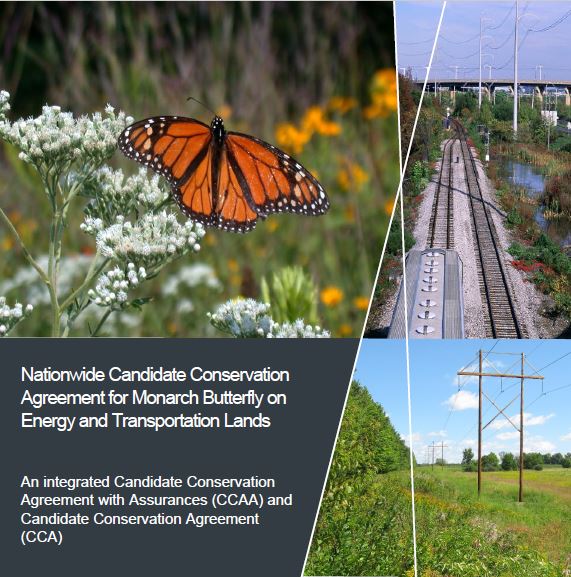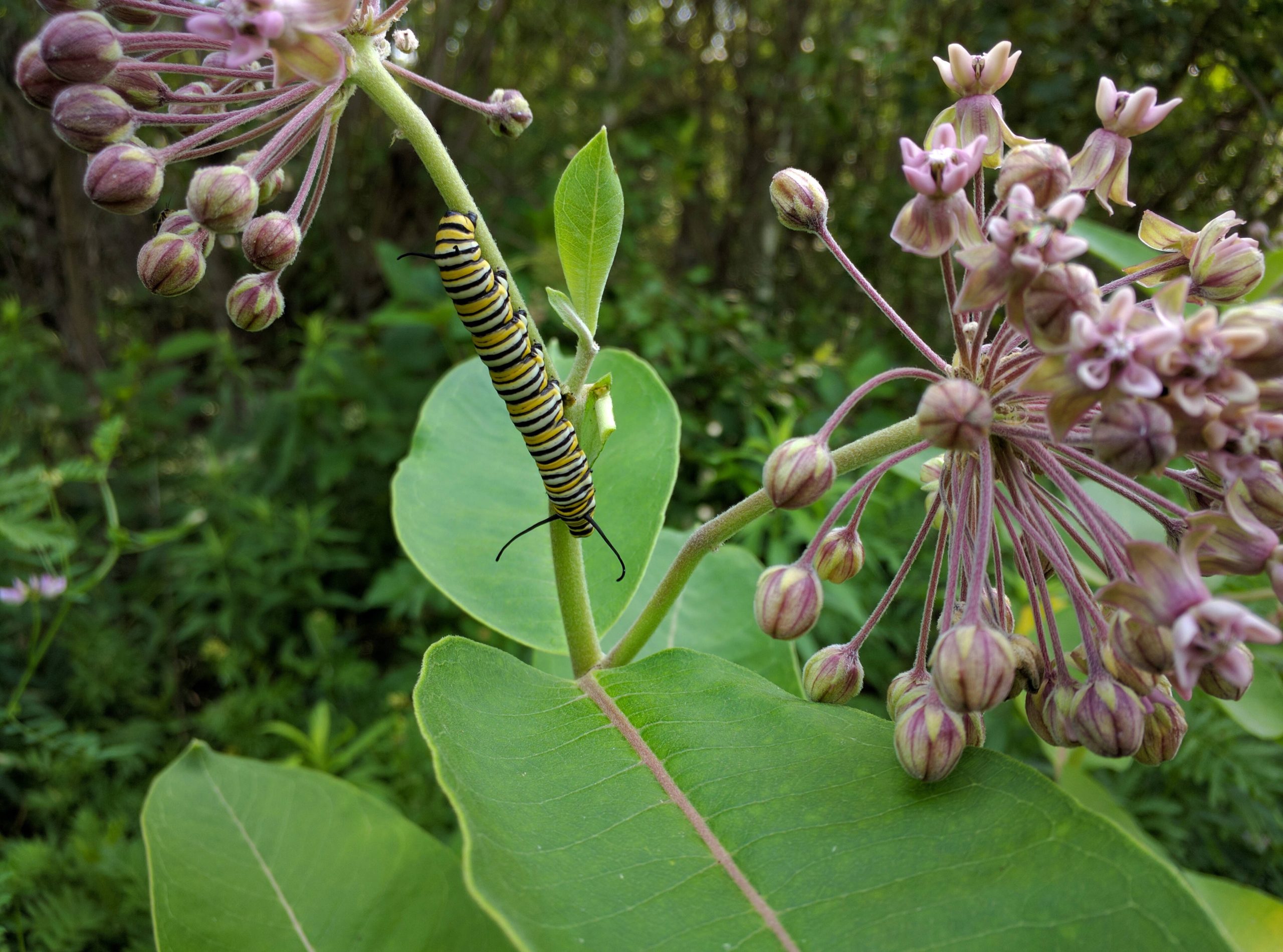Transportation agencies across the nation are working to create and maintain more habitat for the monarch butterfly, as part of a pioneering nationwide effort by rights-of-way owners to help save the species from extinction.
The effort comes amid growing concern about the rapid decline of the monarch butterfly. The U.S. Fish and Wildlife Service is considering listing the species under the Endangered Species Act and is expected to make a formal decision by the end of 2020. A decision to list the species as endangered or threatened would have a sweeping effect on how land is managed in almost every part of the country. Monarch breeding and feeding habitat is located across most of the eastern United States, with additional habitat in western states.
The Minnesota Department of Transportation (MnDOT) is one of a coalition of state DOTs that have been working together over the past few years on an agreement to protect the butterfly and its habitat. The agencies hope the effort will potentially forestall the need to list the monarch butterfly as threatened or endangered, according to Christopher Smith, the Protected Species Program Coordinator at MnDOT and co-chair of the DOT Sector team along with Kris Gade, Roadside Resources Specialist at Arizona DOT. At the same time, the agreement would offer more regulatory certainty to participating agencies if listing occurs.

Once put into effect, the Nationwide Candidate Conservation Agreement with Assurances (CCAA) for Monarch Butterfly on Energy and Transportation Lands will be available to the entire contiguous 48 states. It is the first such nationwide agreement for any species.
“This certainly is in the DOTs’ best interests,” Smith said, adding that “everybody wants to do the right thing” for the monarch. DOTs that participated in developing the monarch agreement include Arizona, California, Colorado, Delaware, Florida, Georgia, Idaho, Illinois, Indiana, Iowa, Maine, Minnesota, Nebraska, Nevada, North Carolina, Ohio, Oklahoma, Texas, Virginia, and Wisconsin.
Rights-of-Way as Habitat
The loss of suitable habitat is the primary reason monarchs have declined in recent years. According to the Rights-of-Way as Habitat Working Group, a project of the University of Illinois at Chicago, transportation and energy rights-of-way present a major opportunity to create or enhance breeding and foraging habitat for monarchs.
Rights-of-way have the potential to add approximately 2.3 million acres of high-quality habitat, including native milkweed plants that the monarchs rely on as host plants for laying their eggs and raising their caterpillars, as well as flowering plants that provide nectar for food.

Once fully implemented, designated acres of roadsides will be managed and maintained to support such habitat. This may mean more restrictions and requirements concerning vegetation management, but the additional work will be offset by regulatory certainty provided by the agreement, Smith said.
Conservation and Predictability
The CCAA agreement, negotiated with the U.S. Fish and Wildlife Service, was created through a coalition of 20 state DOTs, numerous energy companies, federal partners including the Federal Highway Administration, and technical consultants. The CCAA includes “assurances,” allowing participants to voluntarily contribute to species survival by preserving and enhancing habitat. In return, should an Endangered Species Act listing occur, participants will not be required to implement additional conservation measures beyond those in the agreement.
“Transportation projects are planned years ahead of time, and DOTs wanted that predictability and a clear process,” Smith said.
To participate in the agreement, a DOT or energy company would first enroll their rights-of-way under the agreement. Of those enrolled lands, a specified minimum percentage—8% for U.S. and state highways and Interstates; 5% for local roads—will become “adopted acres” that will require active monarch conservation efforts.
Should the butterfly be listed, activities such as construction or maintenance in the right-of-way will be allowed to continue despite the occasional unintentional loss of monarch adults or caterpillars. Also, the DOT or energy company would be required to conduct periodic monitoring to verify that the conservation measures are working.
The agreement encourages the use of integrated vegetation management and diverse groundcover that is both consistent with operations in the right-of-way and supportive of habitat requirements.
Challenges and Lessons Learned
The agreement was developed unusually quickly, especially considering that there were more than 45 parties to the agreement plus the federal partners. “It’s been very successful. We’re all more or less interested in the same thing, so it’s been a relatively smooth process,” Smith said.
Smith said that MnDOT is already considering the challenges to implementing the conservation measures that come with being a large agency. MnDOT’s district office roadside management staffs will need to be trained on the mowing and herbicide procedures to protect monarch habitat. Additionally, with the harsh winters that are common in Minnesota, the accumulation of road salt in the right-of-way would need to be considered to avoid unintentionally harming the butterflies, Smith said.
From the beginning, the effort has received support at various levels of the agency as MnDOT staff recognize the long-term benefits to participation in the agreement.
Next Steps
Smith expects there to be more success stories and challenges as the agreement is put into practice. For instance, not all roadsides are ideal for monarch habitat. While MnDOT intends to enroll most of its highway system—since milkweed grows almost everywhere in Minnesota—the agency will then need to define the conservation acreage, Smith said.
“Everyone has limited resources. We don’t have resources to create habitat everywhere, so we have to decide how to prioritize where it should go,” Smith said.
Help with locating and prioritizing suitable habitat is being provided by the Monarch Joint Venture, a non-governmental organization dedicated to monarch butterfly conservation and research, according to Smith.
Creating the agreement involved cooperation that went beyond state borders and has encouraged discussion of other circumstances that might benefit from a similar effort, according to Smith. “I have no doubt that there will be new and innovative ways to more effectively work across boundaries,” Smith said.
At the same time, state governments all have unique circumstances that influence decision making, Smith said, and as a result, the mix of participants in the agreement may change over time.
MnDOT will face the ongoing need to communicate effectively with the public and within the agency about the benefits and limitations to participation and what, ultimately, is in the best interests of the monarch butterfly, according to Smith.
The U.S. Fish and Wildlife Service has determined that all conservation commitments enrolled under the agreement by May 31, 2020, will help determine whether the monarch will be designated as a listed species.
For more information, including examples of state DOT approaches to enrollment, link to the Rights-of-Way as Habitat Working Group website, to the U.S. Fish and Wildlife Service’s monarch butterfly page, or contact Christopher Smith, Protected Species Program Coordinator, Minnesota DOT, at [email protected] or Kris Gade, Roadside Resources Specialist, Arizona DOT at [email protected].
